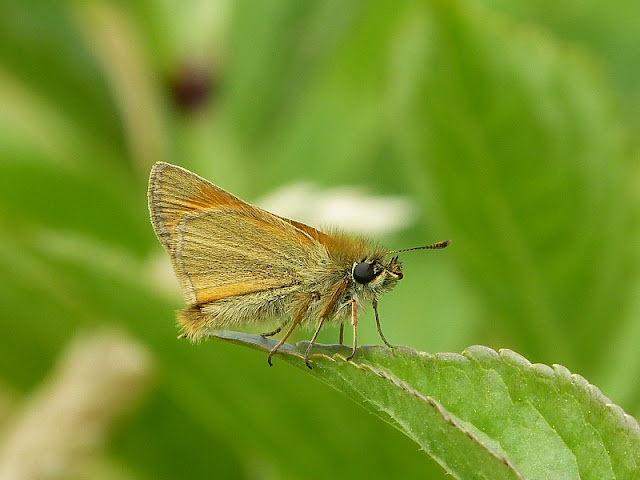Continued from my previous post:
I received a record of a Clouded Yellow just outside Haddington on 9th August. These are rare migrants in Scotland, but more commonly seen in the south of England.
The exciting news was that in August Purple Hairstreaks were seen at Dunglass Dean and Woodhall Dean. These are interesting little butterflies that usually fly high up in Oak trees and they tend to fly in the early evening, rather than earlier in the day. This behaviour may explain why the butterflies haven't been recorded previously in East Lothian, although a lot of effort has been put into searching potential areas of old Oaks and particularly looking at fallen branches and twigs to check for eggs, which are quite easily spotted in the winter. Personally, I think if they had been here in previous years we would have seen them and when you consider how quickly Holly Blues have spread across East Lothian, it is quite possible that Purple Hairstreaks may have spread in from colonies outwith East Lothian.
There were a few species that were not recorded in East Lothian in 2022, but I am sure they were probably present, but just that no one managed to be in the right place at the right time to record them. Green Hairstreaks live in small colonies in the Lammermuir Hills. The colonies I am aware of are quite remote, so require a bit of a hike to find. I thought I had done well when I found them in good numbers at a site on Soutra, but when I started entering the records I realised I had been just south of the East Lothian boundary! There were bound to have been some just a few yards away in East Lothian!!
There were no records of Northern Brown Argus butterflies, although some eggs were found. These butterflies also live in small, scattered colonies where Rockrose grows. There was a concerted effort to visit all areas of known Rockrose in East Lothian in 2022 to search for signs of Northern Brown Argus and to see if the Rockrose was doing well or under threat. Unfortunately, by the time we organised ourselves we were a little too late in the year to see the butterflies! However, eggs were found in areas where Northern Brown Argus haven't been seen in years, if at all. We will make a concerted effort to survey these areas a little earlier this summer.
It was interesting that a number of us saw small, or bonsai, butterflies this year. These included Small Whites and Speckled Woods. I saw a butterfly at Longniddry that I thought was some sort of Hairstreak, but it turned out to be an extremely small Meadow Brown, about the same size as a Common Blue! I have seen very small versions of Large White, Green-veined White and Orange Tips in the past. I wonder if they are a result of reduced food during dry periods, meaning that the caterpillar doesn't grow to its normal size before pupating.
Here is a list of butterflies recorded in East Lothian in order of appearance:
Small Tortoiseshell
Peacock
Red Admira
Comm
Brimstone
Holly Blue
Orange Tip
Small White
Speckled Wood
Green-veined White
Wall Brown
Small Copper
Small Heath
Large White
Large Skipper
Small Skipper
Common Blue
Meadow Brown
Ringlet
Dark Green Fritillary
Painted Lady
Grayling
Clouded Yellow
Purple Hairstreak
If we include the other three species that occur in isolated colonies in East Lothian (Northern Brown Argus, Green Hairstreak and Small Pearl-bordered Fritillary) we get a grand total of 27 species of butterflies for East Lothian in 2023.
I received 1,817 ad hoc records in 2022, totalling 7,278 butterflies. Add in the 5,149 butterflies that were recorded on the transects and we get a grand total of 12,427 that we have collectively recorded. I am very grateful to everyone who has contributed records over the years. This has helped paint a great picture of how things have changed over the years in East Lothian.



.jpg)


